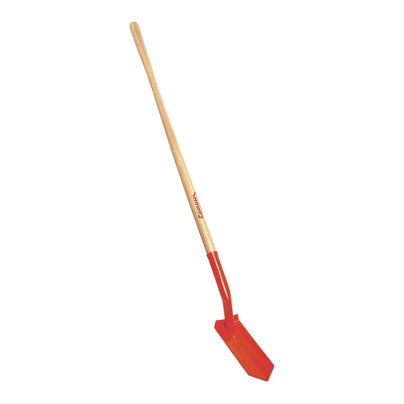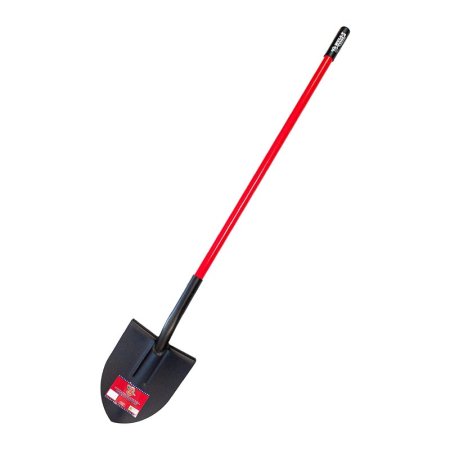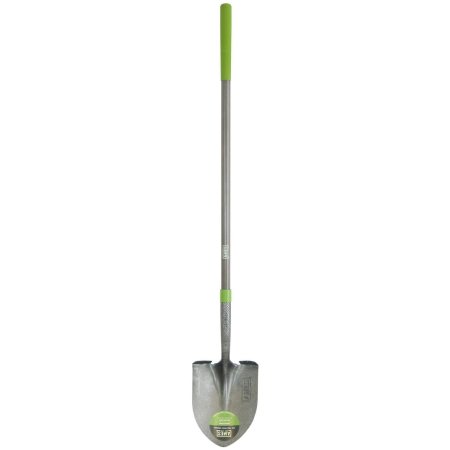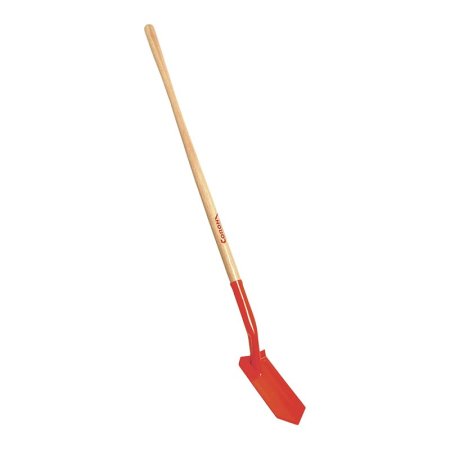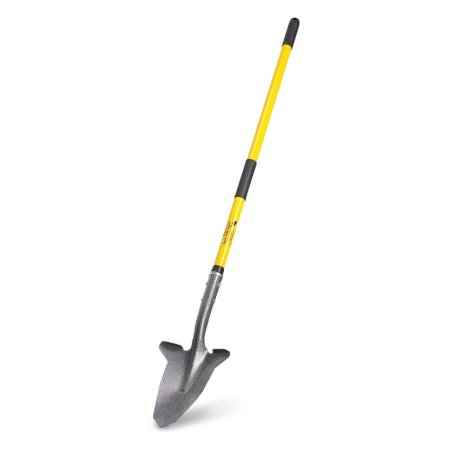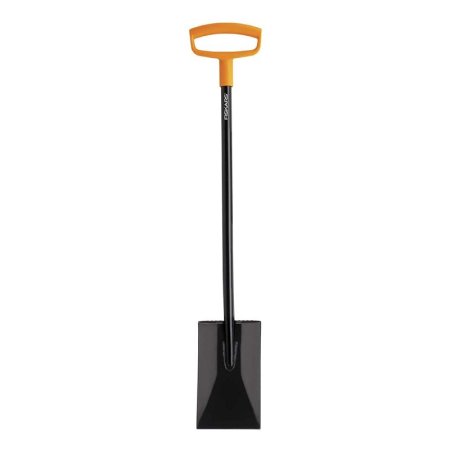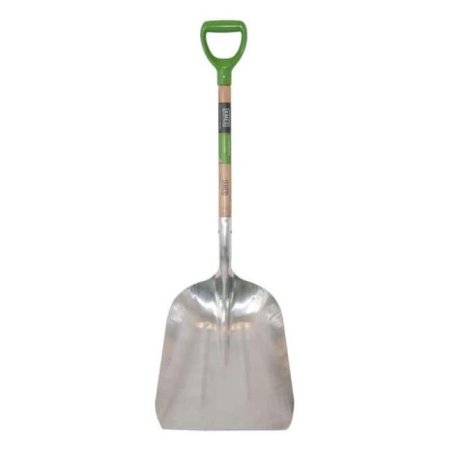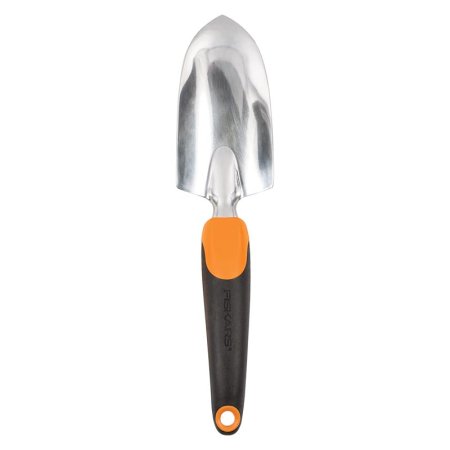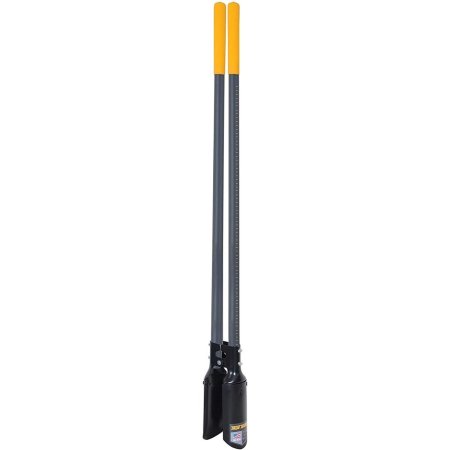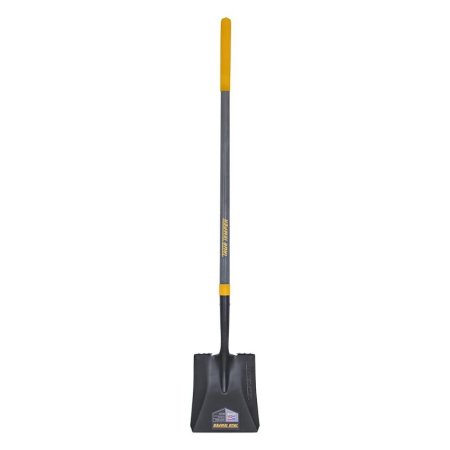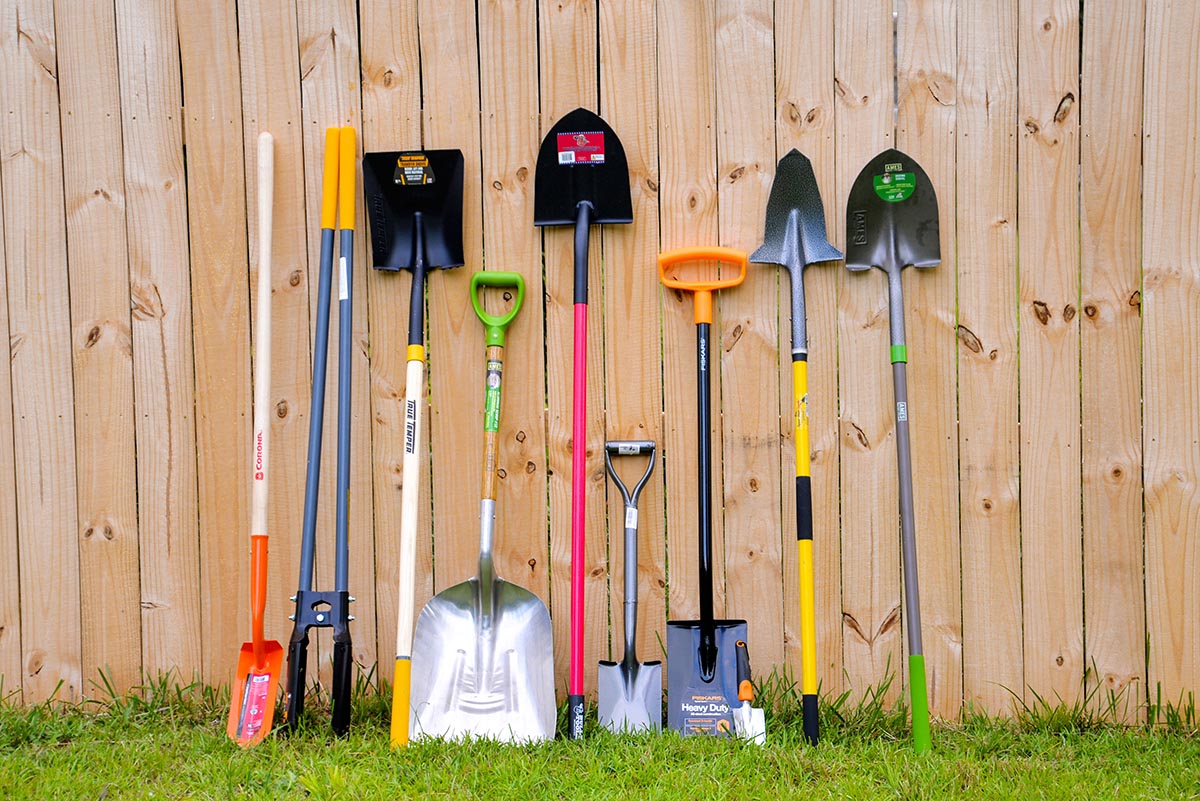
We may earn revenue from the products available on this page and participate in affiliate programs. Learn More ›
The smell of freshly turned earth, the weight of a sturdy shovel, and the view of bedding plants waiting to be placed into the ground can be sources of joy for many gardeners. But knowing which type of shovel is best for the landscaping project on your list may not be as easy as it seems. To help you make a good choice, we tested 10 highly rated shovels and consulted an expert for insights into selecting the right one.
Based on our efforts, we chose the Bully Tools 12-Gauge Round Point Shovel as the best overall option. It’s comfortable in hand, easy to use, and offers excellent performance in a variety of tasks. Still, other garden tools could be better for certain projects, and the rest of the shovels on our list are all great options. Read on to learn how each performed in our tests before choosing one of the best shovels for your gardening needs.
- BEST OVERALL: Bully Tools 12-Gauge Round Point Shovel
↓ Jump to Review - BEST BANG FOR THE BUCK: Ames Long Fiberglass Handle Round-Point Shovel
↓ Jump to Review - BEST TRENCHING: Corona Tools Trench Shovel With Ash Hardwood Handle
↓ Jump to Review - BEST TREE-PLANTING: Spear Head Spade SHLF2 Fiberglass Handle Shovel
↓ Jump to Review - BEST MINI: Z&G D-Handle Mini Spade Shovel
↓ Jump to Review - BEST GARDEN SPADE: Fiskars 46″ Garden Spade Shovel
↓ Jump to Review - BEST GARDEN SCOOP: Ames #12 Aluminum Scoop With D-Handle
↓ Jump to Review - BEST GARDEN TROWEL: Fiskars Ergo Trowel
↓ Jump to Review - BEST POST HOLE DIGGER: True Temper Post Hole Digger With Fiberglass Handle
↓ Jump to Review - BEST FLAT: True Temper Square Point Transfer Shovel
↓ Jump to Review
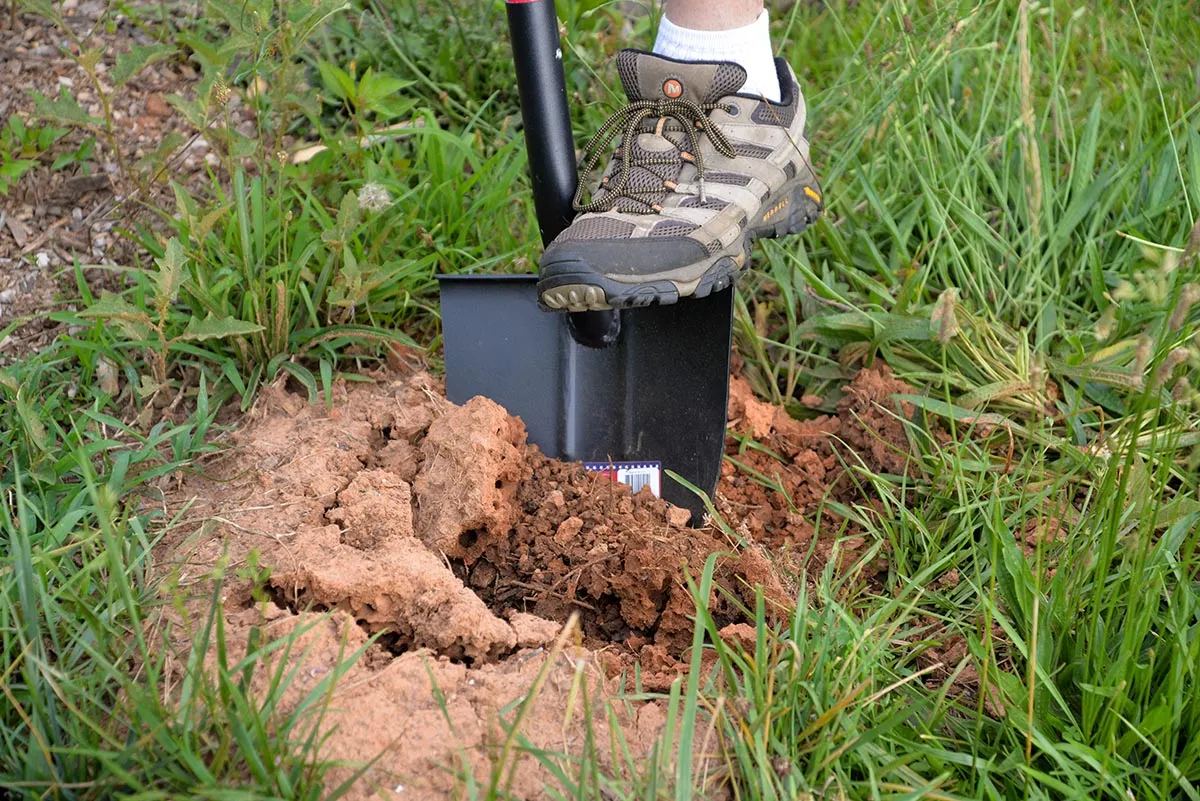
Best Shovels Comparison Chart
| Product Name | Type | Handle | Weight |
| Bully Tools 12-Gauge Round Point Shovel | Digging | Fiberglass, straight | 5.6 pounds |
| Ames Long Fiberglass Handle Round-Point Shovel | Digging | Fiberglass, straight | 4.22 pounds |
| Corona Tools Trench Shovel With Ash Hardwood Handle | Trenching | Hardwood, straight | 4.58 pounds |
| Spear Head Spade SHLF2 Fiberglass Handle Shovel | Tree planting | Fiberglass, straight | 4 pounds |
| Z&G D-Handle Mini Spade Shovel | Spade | Steel, D-handle | 1.98 pounds |
| Fiskars 46″ Garden Spade Shovel | Spade | Steel, D-handle | 4.81 pounds |
| Ames #12 Aluminum Scoop With D-Handle | Scoop | Hardwood, D-handle | 3.52 pounds |
| Fiskars Ergo Trowel | Trowel | Cushioned aluminum | 0.43 pound |
| True Temper Post Hole Digger With Fiberglass Handle | Post-hole digger | Fiberglass, straight | 9.1 pounds |
| True Temper Square Point Transfer Shovel | Transfer | Hardwood, straight | 4.75 pounds |
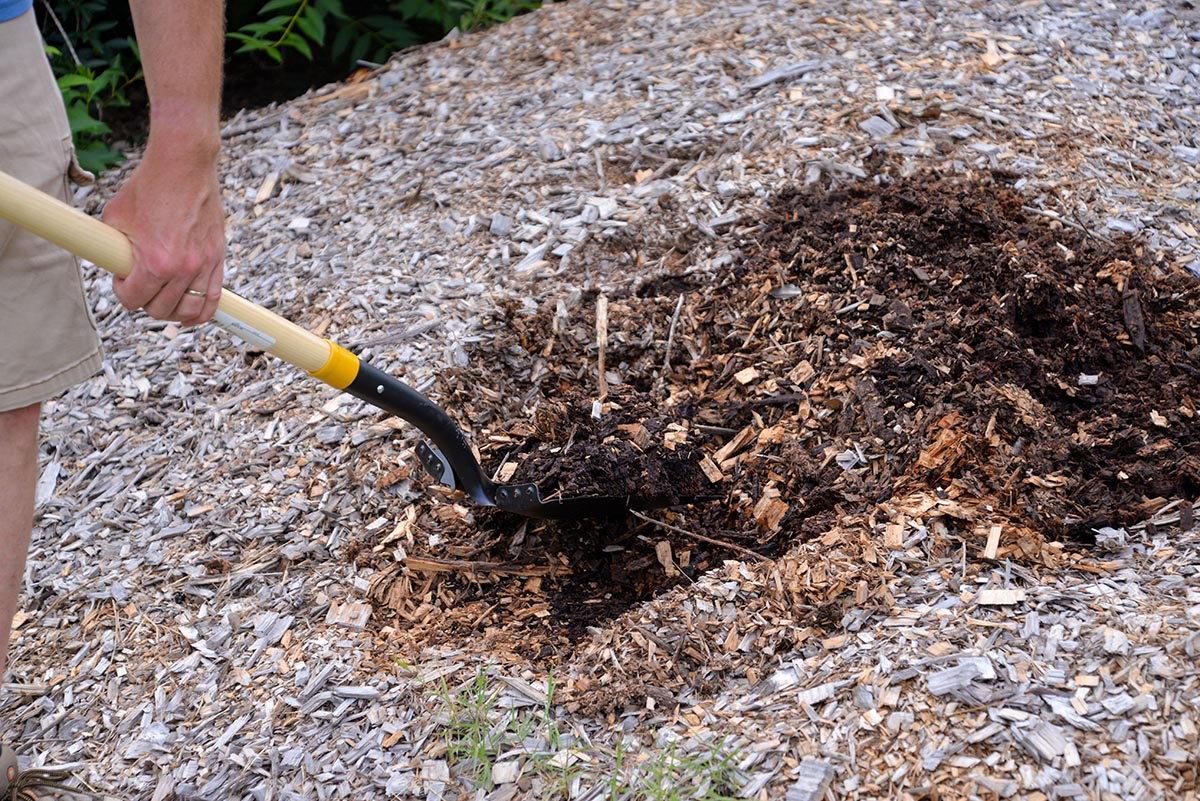
Our Top Picks
The following reviews of our tested top picks can help you decide which shovel is right for digging tasks like planting a vegetable garden or caring for your landscape. the materials that make it more durable in tough applications. While the extra weight might be worth it in some situations, a few extra pounds can make a noticeable difference after several hours of yard work. Ultimately, the ideal weight depends on the user’s own strength and endurance.
Best Overall
Bully Tools 12-Gauge Round Point Shovel
What We Like
- Reinforced 12-gauge steel head
- Closed-back handle socket
- Strong fiberglass handle
- Slip-resistant cushioned grip
What We Don’t Like
- Premium price
- Heavy welds around thinner metal might lead to cracking
Specs
- Type Digging
- Handle Fiberglass, straight
- Weight 5.6 pounds
Our Ratings: Ease of Use 4/5; Comfort 4/5; Performance 4.3/5; Value 4.7/5
Long-handle round-point (LHRP) shovels are the most widely used shovels for general-purpose digging. When this Bully Tools LHRP performed consistently well across all our testing tasks, we knew it was the right choice for our award for best overall.
This model’s stout 12-gauge head powered through hard-packed clay soil and cut cleanly through sod and roots. We appreciated how easy the wide step area made it to use, even though we were wearing soft-soled shoes instead of work boots. And since the handle has a cushioned grip and enough flexibility to absorb the shock of digging without bending under a load of soil, we felt both comfortable and in control as we worked.
One possible downside of this option is that, while it has welded reinforcements for added strength, the area where the socket meets the blade doesn’t seem all that durable. If you try too hard to pry out a rock or thick root (which you should not do), it seems possible that the metal surrounding the weld could break.
This is our go-to shovel since it’s highly efficient for most yard and garden tasks. While it’s not the cheapest opinion, its versatility and overall excellent performance make it well worth the price.
Mark Wolfe, Product Reviews tester and writer
Get the Bully Tools shovel at Amazon, Tractor Supply Co., The Home Depot, Walmart, Northern Tool + Equipment, or Bully Tools.
Best Bang for the Buck
Ames Long Fiberglass Handle Round Point Shovel
What We Like
- Tempered-steel head with wide step area for secure footing
- Steel-reinforced fiberglass handle
- Slip-resistant cushioned grip
- Surprisingly strong for a cheap lightweight shovel
What We Don’t Like
- Open-back handle socket could fail over time
- Thinner steel flexes in heavy-duty applications
Specs
- Type Digging
- Handle Fiberglass, straight
- Weight 4.22 pounds
Our Ratings: Ease of Use 4/5; Comfort 4/5; Performance 4/5; Value 4.7/5
This long-handle round-point shovel from Ames punches above its weight. It features a durable steel-reinforced fiberglass handle with a padded nonslip grip for outstanding comfort and control. The steel blade has an oversized step area and an open socket that’s reinforced with a steel collet. And all this comes at a value price.
Though it costs about half as much as our top pick, this Ames shovel weighs just over a pound less, making it a better all-purpose option for projects that don’t require heavy-duty reinforcements. The thinner steel used in the shovel head adds to its lightness but also allows it to flex slightly, so it is less aggressive in hard-packed clay soil and subject to more wear and tear in rocky ground. It’s also reinforced with an inner layer of steel to help resist cracking at the stress points, but the open-back handle sock seems like a possible failure point.
Get the Ames round-point shovel at Amazon, The Home Depot, or Walmart.
Best Trenching Shovel
Corona Tools Trench Shovel With Ash Hardwood Handle
What We Like
- Narrow head and deep angle for efficient trenching
- 12-gauge-steel head with closed-handle socket
- Impact-resistant hardwood handle
What We Don’t Like
- Limited applications beyond trenching
Specs
- Type Trenching
- Handle Hardwood, straight
- Weight 4.58 pounds
Our Ratings: Ease of Use 4/5; Comfort 5/5; Performance 4/5; Value 4.3/5
The Corona trench shovel is purpose-built for digging narrow trenches in any type of soil, making it essential for installing irrigation lines, running power for landscape lighting, and creating planting furrows for gardening. Since its 12-gauge steel blade is only 4 inches wide, it removes less than half the width of a round-point digging shovel. This unique design is ideal for precision digging, ensuring you don’t waste time and energy removing more dirt than is necessary.
In our tests, this trench shovel performed exceptionally well in heavy clay soil, maneuvering smoothly around rocks. It also has a high-angle closed-handle socket that makes it easy to scoop out a flat trench bottom, while the lightweight hardwood handle provides excellent strength and shock resistance. Unlike some “cleanout”-style trench shovels, this one does not have raised sides to hold in a large volume of loose material, but it digs a new trench in packed earth more efficiently than a cleanout shovel could.
Get the Corona Tools shovel at Amazon, Tractor Supply Co., Ace Hardware, Walmart, or Corona Tools.
Best Tree-Planting
Spear Head Spade SHLF2 Fiberglass Handle Shovel
What We Like
- Works well in rocky, heavy, and hard-packed soils
- Manganese steel head cuts roots cleanly and stays sharp
- Comfortable padded grips
What We Don’t Like
- Premium price
- Small surface area, works slowly
Specs
- Type Tree planting
- Handle Fiberglass, straight
- Weight 4 pounds
Our Ratings: Ease of Use 3.75/5; Comfort 5/5; Performance 4.6/5; Value 4.3/5
When you’re planting a tree or transplanting a shrub, you need a shovel that can contend with packed soil, random rocks, and tough roots. The Spear Head Spade gardening shovel is designed with those tough tasks in mind. Its unique spearhead-shaped blade is made of hardened manganese steel and features a wide step and sharp edge, allowing it to find its way naturally to the path of least resistance and slice cleanly through roots. The open-back socket is reinforced with a steel collet and rubber gasket to boost strength and reduce shock. The straight fiberglass handle has two padded nonslip grips for superior comfort and control.
We tested the Spear Head Spade alongside similar digging tools like shovels and spades. It worked as well as any of those other hand garden tools, loosening and scooping like a digging shovel but offering the precision of a spade. It easily cut through the thick main root coming off a parent oakleaf hydrangea yet allowed us to keep the root ball intact for easy relocation to a new site. This model’s compact, efficiently designed head and comfortable grips also make this a good choice for those with impaired strength and mobility, but the high price could be a barrier.
Get the Spear Head Spade shovel at Amazon, Walmart, or Spear Head Spade.
Best Mini
Z&G D-Handle Mini Spade Shovel
What We Like
- Durable kid-size or kneeling garden spade
- Great for large container digging or cleaning fireplaces
- Easy to use with 1 hand
- All-steel construction
What We Don’t Like
- Too small for most adults to comfortably use while standing
Specs
- Type Spade
- Handle Steel, D-handle
- Weight 1.98 pounds
Our Ratings: Ease of Use 3.5/5; Comfort 3/5; Performance 4/5; Value 4/5
Short-handled shovels are useful when working in tight spots, and with this mini shovel, gardeners can easily dig holes, move dirt, apply compost, or remove stubborn weeds. This flat-head shovel has a strong metal shaft, a rust-resistant steel head with a sharpened edge, and a D-shaped nonslip grip to keep your hands from cramping during work. The entire tool measures just shy of 30 inches and weighs less than 2 pounds.
When this small shovel arrived, we first thought it was a toy. It’s shorter than our main tester’s shirt sleeves, and when the blade is buried in the soil, the top of the handle is only knee-high. But as we used it in our garden, we were surprised by how sturdily built it is. It’s lightweight enough to use one-handed and feels almost like an oversized trowel (or undersized spade). For most adults, it will be best for tasks like preparing soil in large containers or doing up-close work (on hands and knees) in raised beds. The Z&G mini spade would make an outstanding first garden spade for a child.
Get the Z&G shovel at Amazon.
Best Garden Spade
Fiskars 46" Garden Spade Shovel
What We Like
- Durable construction
- Lightweight, medium-duty design
- Comfortable to use
- Sharp edge for easier digging
What We Don’t Like
- Poly handle is less durable than steel
- Thick welds could lead to breaks in tough conditions
Specs
- Type Spade
- Handle Steel, D-handle
- Weight 4.81 pounds
Our Ratings: Ease of Use 4/5; Comfort 5/5; Performance 4.6/5; Value 4/5
Whether the goal is to slice through thick roots, neaten up the edges of the lawn, or move a pile of compost or soil, this Fiskars flat-top garden spade is up to the task. This extremely sturdy spade weighs under 5 pounds yet has a steel shaft, a hardened steel blade, and an extra-large D-shaped handle that’s big enough for both hands. It also features a nonslip grip that increases comfort when cutting through compacted soil and clay or slicing through dense sod.
The shaft on this spade is a bit longer than average, which is great for taller gardeners. However, since the shaft and the rest of this shovel are steel, it would be nice if it also had a built-in steel handle instead of an attached one made of polyresin that could fail over time. Also, while the tool is welded, the metal around strong welds can break if stressed excessively. Still, so long as it’s only needed for moderate-duty tasks, this will be an excellent and likely long-lasting choice.
What our tester says: “We really like this spade’s oversized D-handle, longer shaft length, and reinforced blade. It’s more comfortable and less fatiguing than our old garden spade for tasks like digging in soil or moving dirt. “—Mark Wolfe, Product Reviews tester and writer
Get the Fiskars spade shovel at Amazon, Ace Hardware, Walmart, or Northern Tool + Equipment.
Best Garden Scoop
Ames #12 Aluminum Scoop With D-Handle
What We Like
- Broad scoop blade increases efficiency
- Short handle and sturdy D-grip offer excellent control
- Lightweight and easy to use
What We Don’t Like
- Specialty shovel with limited application
Specs
- Type Scoop
- Handle Hardwood, D-handle
- Weight 3.52 pounds
Our Ratings: Ease of Use 5/5; Comfort 4/5; Performance 4/5; Value 4.6/5
If you need to scoop and move garden fertilizer, mulch, soil amendments, lightweight gravel, or even a bit of snow, this Ames garden scoop is an excellent choice. It weighs under 5 pounds and features a rustproof aluminum alloy blade that curves up at the sides and back, helping it handle large loads without difficulty. It also has a 26-inch hardwood shaft that’s topped with a soft, comfortable D-shaped handle with a nonslip grip.
In some ways, the Ames scoop shovel was difficult to test. Unlike the other shovels in our lineup, it’s not really the type of shovel you’d generally reach for when working with soil. However, we ended up using it to load compost and mulch onto a wheelbarrow from our driveway, and we were incredibly happy with how quickly we were able to complete the task. It worked like a giant transfer shovel, with the oversized scoop head and flat edge making it extremely easy to collect the relatively lightweight particles. Farmers, homesteaders, and serious gardeners will appreciate this tool for working with soil amendments, fertilizers, and animal feed by the cubic yard.
Get the Ames D-handle shovel at The Home Depot or Acme Tools.
Best Garden Trowel
Fiskars Ergo Trowel
What We Like
- Lightweight and comfortable to use
- Rustproof
- Comfortable, slip-resistant grip
What We Don’t Like
- Cast aluminum is not for levering rocks and roots
- Edge is marginally sharp
Specs
- Type Trowel
- Handle Cushioned aluminum
- Weight 0.43 pound
Our Ratings: Ease of Use 4/5; Comfort 5/5; Performance 4/5; Value 5/5
Gardeners who work in raised beds or plant lots of seedlings know the value of a good garden trowel. The Fiskars Ergo Trowel is a lightweight, inexpensive tool made of rust- and corrosion-resistant cast aluminum. Its ergonomic cushioned hand grip has a textured nonslip coating for sure-handed gardening.
Despite the fact that our testers have vastly different hand sizes, this trowel felt comfortable in hand for us both. We found it useful for planting 4-inch seedlings in garden soil and repotting a range of houseplants, but the trowel’s edge wasn’t sharp enough for us to create clear divisions in clumps of oregano and thyme. Also, although cast aluminum resists rust and corrosion really well, it is a brittle material that breaks easily. To avoid damage, we didn’t test this trowel for tasks like prying up established perennials or turning previously untilled soil. However, this is an excellent choice if you need a medium-duty trowel for working in established garden beds or with potted plants.
Get the Fiskars trowel shovel at Amazon, Target, or Blain’s Farm & Fleet.
Best Post Hole Digger
True Temper Post Hole Digger With Fiberglass Handle
What We Like
- Durable with steel-reinforced fiberglass handles
- Heavy enough to penetrate hardened clay soil
- Markings on the handle help gauge hole depth
- Comfortable grips
What We Don’t Like
- Specialized tool with limited application
Specs
- Type Post-hole digger
- Handle Fiberglass, straight
- Weight 9.1 pounds
Our Ratings: Ease of Use 5/5; Comfort 5/5; Performance 4/5; Value 4.3/5
This True Temper post hole digger is designed to penetrate and loosen compacted soil and clay before removing it in preparation for fence posts, deck footers, and more. Its durable steel blades open when the handles are together and form a closed scoop when pulled apart, allowing you to create perfectly round vertical holes without leaving loose dirt behind. Thanks to its lightweight steel-reinforced fiberglass handles, this post hole digger only weighs about 9 pounds. One handle has a built-in ruler for accurate depth measurement, and both are topped with high-visibility yellow cushion grips that increase control and comfort.
We tested this tool while installing a row of twenty 4×4 fence posts 30 inches deep. We appreciated the smooth functioning of the pivot hinge and the fact that this model weighed less than the wood-handled model we’d used before testing. While the fiberglass handles transmitted slightly more vibration and shock than the wood-handled version, we did find them more comfortable to grip.
What our tester says: “Having used a few post hole diggers in our time, we were incredibly happy this model’s handles didn’t pinch our hands like others we’ve used. It also comes at a great price, which is nice since it’s a single-task tool.”—Mark Wolfe, Product Reviews tester and writer
Get the True Temper post-hole shovel at Amazon or Acme Tools.
Best Flat
True Temper Square Point Transfer Shovel
What We Like
- Durable materials
- Comfortable to use
- Moves large quantities of material easily
- Cleans ice, soil, or mud from paved surfaces
What We Don’t Like
- Open-back handle socket may loosen with heavy use
Specs
- Type Transfer
- Handle Hardwood, straight
- Weight 4.75 pounds
Our Ratings: Ease of Use 5/5; Comfort 5/5; Performance 4/5; Value 4.3/5
A flat shovel is the best tool for moving piles of bulky material or cleaning up ice or mud from pavement—and we wanted to test the True Temper square-point shovel for these tasks because of its light weight and durable construction. The steel head on the True Temper features a wide step and open back secured to a hardwood handle with a steel ferrule for added strength. The hardwood handle not only reduces weight but also absorbs shock and vibration, making scraping and cleanup tasks more comfortable.
In our tests, the hardwood handle stood out for its general comfort. It’s light, slightly flexible, and naturally easy to grip, especially with bare hands. The shovel performed well when moving soil, mulch, and gravel on both paved and unpaved surfaces.
True Temper also offers this shovel with a fiberglass handle or a shorter D-handle, which may be preferable for stabilizing heavier loads like gravel. However, we found this long-handled version to be an excellent all-purpose tool. A flat shovel is one of those tools you may not realize you need until you have one, and this model proves that point.
Get the True Temper square-point shovel at Amazon.
Jump to Our Top Picks
How We Tested the Best Shovels
The collection of shovels we tested was diverse, and some models are designed for highly specific tasks. To give each model a fair shake, we planned different tests for each shovel type and sometimes used more than one shovel to complete a certain project.
To test the digging shovels, trench shovel, and garden spade, we removed sod and turned soil for a new garden bed. Since we were in the middle of a fence post installation project, we swapped out our old post hole digger for the one in this guide. That same project left us with mounds of soil to remove from the ground adjacent to the installed posts—a perfect job to test the flat shovel. We also transplanted a tree with the tree-planting shovel, planted seedlings with the trowel, and worked up a raised bed with the mini spade.
Once our tests were complete, we rated each tool’s abilities. The shovels that made our list will meet the demands most homeowners would expect, including periodic heavy-duty use.
| Ease of Use | Comfort | Performance | Value | |
| Bully Tools 12-Gauge Round Point Shovel | 4 | 4 | 4.3 | 4.7 |
| Ames Long Fiberglass Handle Round-Point Shovel | 4 | 4 | 4 | 4.7 |
| Corona Tools Trench Shovel With Ash Hardwood Handle | 4 | 5 | 4 | 4.3 |
| Spear Head Spade SHLF2 Fiberglass Handle Shovel | 3.75 | 5 | 4.6 | 4.3 |
| Z&G D-Handle Mini Spade Shovel | 3.5 | 3 | 4 | 4 |
| Fiskars 46″ Garden Spade Shovel | 4 | 5 | 4.6 | 4 |
| Ames #12 Aluminum Scoop With D-Handle | 5 | 4 | 4 | 4.6 |
| Fiskars Ergo Trowel | 4 | 5 | 4 | 5 |
| True Temper Post Hole Digger With Fiberglass Handle | 5 | 5 | 4 | 4.3 |
| True Temper Square Point Transfer Shovel | 5 | 5 | 4 | 4.3 |
What to Consider When Choosing a Shovel
Before choosing one of the best gardening shovels for your maintenance tasks, consider which shovel type, material construction, length, weight, and grip will work best. With a bit of advanced planning, you can select the best gardening tool for your needs.
Type
While most people have experience with a round-point or flat-head shovel for all-purpose digging, there are actually many more types of shovels to consider. Shovel type is based on blade shapes, handle design, and purpose and includes digging shovels, trenching shovels, tree-planting shovels, edging shovels, mini shovels, trowels, spades, scoops, and post hole diggers.
- Digging shovels have a concave blade with a small flattened platform (collar) where you can place your foot for extra force when pushing the tool into the ground. Square digging shovels are useful for edging, digging a hole to plant a bush or perennials, and trenching. Tools with pointed tips are great for breaking up hard-packed soil, while round tips are ideal for softer soil and transplanting.
- Trenching shovels have long, narrow blades that come to a slight point. These handy tools are built for digging drains or creating trenches for irrigation systems.
- Tree planting shovels are intended for quickly and effectively digging a hole to plant a tree. These shovels have a similar shape to trenching shovels, with narrow, curved blades and a pointed tip that penetrates through tough dirt to create circular holes for transplanting trees.
- Edging shovels aren’t made for digging. Instead, these shovels have broad semicircle blades and a straight footplate that you can step on to edge the lawn or garden. The blade cuts away the lawn or soil, creating a clean border that prevents grass from spreading to the garden or pathway and stops the spread of weeds from the garden into the lawn.
- Mini shovels are similar to full-size shovels but with shorter shafts and slightly smaller blades, which give the user better maneuverability in tight spaces. Some mini shovels can also fold in half, making them much easier to pack for a campsite.
- Trowels are a type of small, handheld garden shovel with a rounded or pointed shovel blade. The shafts are generally only about 6 inches long, making them ideal for digging up weeds in the garden without harming the surrounding plants. They are also useful for digging small holes for new plants.
- Spades have a flat-edge blade perfect for cutting through roots or tough soil. They are also useful for moving small amounts of dirt, garden debris, or soil amendments because, like a shovel, the blade is normally somewhat concave. Spades often have a collar for adding extra foot power when needed.
- Scoops have large, flat blades with sidewalls to keep the contents in place. Garden scoops aren’t for digging, but they’re the tool of choice for moving large piles of dirt, soil amendments, leaves, and other debris, gravel, and mulch.
- Post hole diggers have a unique appearance that resembles two shovels connected at the shaft. The blades are long and narrow, and they face each other to form a scoop that can lift dirt straight up and out of a narrow hole.
Blade Material and Construction
Almost all digging shovels and garden spades have steel blades. Steel is heavier and more durable than aluminum. While aluminum is prone to denting and bending, it is less expensive and better at resisting rust. If you are considering a shovel with steel blades, look for models with a rust-resistant coating.
Low-end shovels generally have stamped steel blades, meaning the blade and attachment to the shaft were machine-stamped from a sheet of steel. High-quality shovels have forged blades, meaning the blade started as a single piece of heated steel that was then hammered into shape. Forged steel blade tools are more expensive, but they also last longer.
Also, take note of the socket where the handle is inserted into the blade (head). Forged shovel heads have a solid socket with no seam, which makes for an extremely strong attachment. Stamped shovel heads have a narrow opening or seam at the back. If there is a seam, it may be reinforced either by welding or with a steel ring at the top called a collet. The seams on some shovels are not reinforced.
Shaft Length and Material
Garden shovels, spades, and scoops usually have a shaft between 44 and 48 inches long, which is a comfortable length for most people. There are also shorter shovels and spades, with shafts measuring between 18 and 24 inches in length. Longer shafts generally provide better leverage and are easier on the user’s back. When working in a confined area, a short shovel is usually the better choice.
The most common shaft materials for shovels are wood, fiberglass, and steel.
- Wood is usually the most affordable option, but these shovels may not stand up to tough jobs. Wood is prone to splintering and snapping from heavy use or age, plus wood is not as weatherproof as other materials.
- Steel is the heaviest type of shaft and is usually chosen for heavy-duty applications.
- Fiberglass is lighter than steel or wood, and it’s more flexible. It’s also durable and better at resisting rust and extreme temperatures.
Handle and Grip
Well-designed shovels have a handle and grip that provide good traction, protect against blisters, and limit hand fatigue. On longer tools, the grip is most often made of heavy plastic or rubber. Ergonomic tools have a textured grip, providing a more secure hold on the shovel.
Some shovels simply have a grip built into the shaft, others have a D-shaped or round handle, and a few have textured grips on both the shaft and the handle. D-shaped and round handles allow you to grasp the top of the shovel with one hand and the shaft with another for more leverage.
Weight
Most full-length garden shovels and spades weigh between 4 and 6 pounds, while some handheld tools weigh 2 pounds or less. Shovels containing fiberglass and aluminum fall on the lower end, while wood and steel shovels have more weight.
Consider a shovel’s weight carefully. A shovel may be heavier due to the materials that make it more durable in tough applications. While the extra weight might be worth it in some situations, a few extra pounds can make a noticeable difference after several hours of yard work. Ultimately, the ideal weight depends on the user’s strength and endurance.
FAQs
Shovels are simple tools, but they come in a wide range of types and sizes that make them appropriate for a variety of tasks, including gardening, planting bushes or shrubs, and digging fence postholes. For more information about these common gardening tools, review the following commonly asked questions and their answers.
Designed with a fiberglass handle and a forged steel blade to penetrate and break through thick roots, the Bully Tools 12-Gauge Round Point Shovel is one of the best options for digging up roots buried deep in the lawn or garden.
To get tips on how to store shovels, we reached out to Michael Clarke, landscape architect, horticulturalist, and founder of Yardwork. According to Michael, “Shovels are best stored by hanging on a wall. This allows them to be up and out of the way so there is less chance for them to slip and fall onto something nearby. Additionally, they are more protected from water that can cause rust and damage if allowed to pool around the head of a shovel.”
The best material for a shovel will depend on the project it’s needed for. Many shovels and professional gardening tools are made with steel since steel is strong and durable. However, steel tools can be heavy. Aluminum shovels are lighter, less expensive, and better at resisting rust, but they are prone to denting and bending.
Michael Clarke, founder of the online nursery Yardwork, recommends sharpening a shovel for a garden two or more times per year, depending on use. “Sharp shovels are able to break through the ground better, divide perennials and shrubs easier by slicing through roots quickly, and move through thick materials like mulch and debris,” he says.
Yes, cleaning a shovel after use can prevent it from rusting or accidentally spreading disease. In our guide on how to care for garden tools, we detail the ideal process, which includes removing dirt with a wire brush, disinfecting with diluted bleach, removing rust with vinegar, and oiling wooden handles.
Meet the Tester
Mark Wolfe is a writer and product tester with a background in the nursery and landscaping industry. For more than 20 years he mowed, edged, planted, pruned, cultivated, irrigated, and renovated beautiful landscapes. Now he tests and writes reviews about the latest outdoor power equipment, hand tools, lawn care products, and other outdoor-living goods.
Additional research provided by Michelle Ullman and Timothy Dale.


